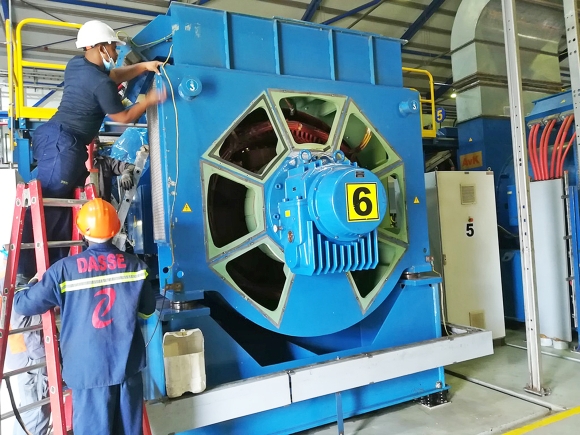An Innovative solution was devised by a repair team from LH Marthinusen (LHM) when it was required to perform on-site repairs on six large 11155kVA alternators in a diesel power plant in Zambia’s Copperbelt.
The plant, which generates power for the city of Ndola, is owned by the state’s Ndola Energy Company and managed and operated on its behalf by Cape Town based Wartsila South Africa, which contracted LHM’s Rotating Field Services division to identify faults in the alternators and perform the repairs found to be required.

“Due to the large size of the alternators, especially the great weight of each rotor, we had to devise a special solution to enable us to do the repairs on site,” said Wesley Houghton, Large Rotating Machines’s Field Service Manager.
“The fact that the heavy rotor could not be moved out of the way to give us access to the stator in each case meant having to devise an alternative way of gaining access to the entire length of the core,” he explained.
After an on-site inspection conducted by Senior Field Services Technician Frans van der Merwe, the team designed and had manufactured locally a special platform as a support structure for the stator. In this way the stator of each machine could be kept in position to be opened and worked on while the rotor was held in suspension, with the drive-end of the rotor still located in the bearing housing.
Once the work was complete the stator and rotor could be re-assembled easily and the team then repeated the process on the other machines.
“We found on inspection that in each of the six machines some stator core wedges had been dislodged and destroyed during operation and had to be replaced,” said Wesley.
A total of about 25 newly-manufactured wedges were required for all six machines to replace those lost. “This represents a very small proportion of the total,” Wesley pointed out.
The replacement stator core wedges were manufactured at LHM’s main repair facility in Denver, Johannesburg.
Each rotor and stator when disassembled was cleaned individually using dry ice and each entire unit was also dry ice cleaned. The repair team also removed the drive-end and non-drive-end bearings of the alternators for bearing inspection, cleaned the housings and fitted new bearing housing insulation.
“In addition, we checked bearing clearances and conducted electrical tests comprising an insulation resistance test and a polarisation index test,” Wesley added.
Three separate trips were made by the team between February and July last year to perform the required work.

